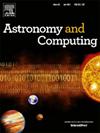Physics-informed Lane-Emden solvers using Lynx-Net: Implementing radial basis functions in Kolmogorov representation
IF 1.8
4区 物理与天体物理
Q2 ASTRONOMY & ASTROPHYSICS
引用次数: 0
Abstract
This paper introduces a novel approach for solving Lane-Emden equations using Lynx-Net, a Physics-Informed Neural Network that integrates Radial Basis Functions (RBFs) within the Kolmogorov representation framework. Lynx-Net addresses these challenges by combining RBF-enhanced function approximation with physics-informed constraints: differential-equation residuals are enforced during training, ensuring stability and rapid convergence. Across a spectrum of polytropic indices, our experiments show that Lynx-Net consistently outperforms prior machine-learning approaches, achieving lower errors without incurring excessive computational cost. The proposed model leverages the function approximation capabilities of RBFs and physics-informed constraints to enhance solution stability and convergence. By incorporating differential equation residuals into the learning process, Lynx-Net minimizes errors while maintaining computational efficiency. Experimental results across multiple test cases demonstrate its superiority over conventional solvers and existing machine learning-based approaches. This research highlights the potential of integrating RBFs with PINNs for solving nonlinear differential equations, providing a scalable and efficient framework applicable to broader problems in astrophysics and engineering.
使用Lynx-Net的物理知情Lane-Emden解算器:在Kolmogorov表示中实现径向基函数
本文介绍了一种使用Lynx-Net求解Lane-Emden方程的新方法,Lynx-Net是一种物理信息神经网络,在Kolmogorov表示框架内集成了径向基函数(rbf)。Lynx-Net通过将rbf增强的函数近似与物理信息约束相结合来解决这些挑战:在训练期间强制执行微分方程残差,确保稳定性和快速收敛。我们的实验表明,在一系列多向指标中,Lynx-Net始终优于先前的机器学习方法,在不产生过多计算成本的情况下实现更低的误差。该模型利用rbf的函数逼近能力和物理信息约束来增强解的稳定性和收敛性。通过将微分方程残差纳入学习过程,Lynx-Net在保持计算效率的同时最大限度地减少了错误。跨多个测试用例的实验结果表明,它优于传统的求解器和现有的基于机器学习的方法。这项研究强调了将rbf与pin结合解决非线性微分方程的潜力,为天体物理学和工程中更广泛的问题提供了一个可扩展和有效的框架。
本文章由计算机程序翻译,如有差异,请以英文原文为准。
求助全文
约1分钟内获得全文
求助全文
来源期刊

Astronomy and Computing
ASTRONOMY & ASTROPHYSICSCOMPUTER SCIENCE,-COMPUTER SCIENCE, INTERDISCIPLINARY APPLICATIONS
CiteScore
4.10
自引率
8.00%
发文量
67
期刊介绍:
Astronomy and Computing is a peer-reviewed journal that focuses on the broad area between astronomy, computer science and information technology. The journal aims to publish the work of scientists and (software) engineers in all aspects of astronomical computing, including the collection, analysis, reduction, visualisation, preservation and dissemination of data, and the development of astronomical software and simulations. The journal covers applications for academic computer science techniques to astronomy, as well as novel applications of information technologies within astronomy.
 求助内容:
求助内容: 应助结果提醒方式:
应助结果提醒方式:


